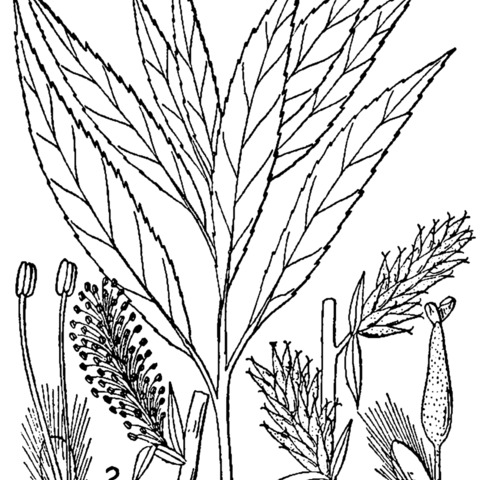Plants 1-6 m. Stems: branches red-brown or violet, not or weakly glaucous, (dull or slightly glossy), puberulent; branchlets yellow-green to red-brown, sparsely pubescent or moderately densely velvety, (buds alba-type or intermediate). Leaves: stipules rudimentary or absent; petiole shallowly grooved adaxially, 3-11 mm, pubescent, or velvety to glabrescent adaxially; largest medial blade lorate or very narrowly elliptic, 38-110 × 6-19 mm, 5-9 times as long as wide, base cuneate or convex, margins flat to slightly revolute, entire, serrate, serrulate, or spinulose-serrate, apex acute to acuminate, abaxial surface glaucous, densely long-silky to glabrescent, hairs (white, sometimes also ferruginous), adaxial dull or slightly glossy, glabrous or sparsely pubescent, (hairs white, sometimes also ferruginous); proximal blade margins sometimes serrulate; juvenile blade moderately densely long-silky abaxially, hairs white, sometimes also ferruginous. Catkins flowering as leaves emerge; staminate stout to globose, 12-29 × 6-17 mm, flowering branchlet 0.8-3 mm; pistillate loosely flowered, stout to globose, 12-39 × 6-18 mm, flowering branchlet 1-11 mm; floral bract brown, tawny, light rose, or bicolor, 1-2 mm, apex rounded, abaxially sparsely hairy, hairs straight. Staminate flowers: adaxial nectary square, ovate, or oblong, 0.3-0.7 mm; filaments distinct, hairy basally; anthers purple turning yellow, ellipsoid or globose, 0.4-0.6 mm. Pistillate flowers: adaxial nectary oblong to ovate, 0.3-0.9 mm; stipe 1.5-4 mm; ovary pyriform, beak abruptly tapering to styles; ovules 6-12 per ovary; styles 0-0.5 mm; stigmas slenderly to broadly cylindrical, 0.26-0.4-0.8 mm. Capsules 5-9 mm. 2n = 38.
More
Clumpy shrub to few-stemmed tree (northward), (1–)2–7 m; twigs slender, yellowish and puberulent to dark brown and glabrous; stipules minute or none; petioles slender, 5–15 mm; lvs narrowly lanceolate or narrowly oblanceolate, 4–10(–15) × 0.8–2(–3) cm, acute to acuminate, subentire to closely glandular-serrulate, densely sericeous on both sides when unfolding from the bud, later dark green and glabrous above, glabrous and glaucous beneath (rarely more persistently hairy); catkins with the lvs, 1–3.5 cm, lax, subsessile or on bracteate peduncles 1–2 cm; scales 1.5–2 mm, brown, thinly villous; stamens 2; frs lanceolate-rostrate, 4–8 mm, thinly sericeous; pedicels 2.5–5 mm; style 0.1–0.5 mm; 2n=38. Moist meadows, stream-banks, and lake-shores; N.B. to N.J. and Pa., w. to Alta., n. Nebr., and Colo. Low shrubs with small lvs 3–6 cm and subentire have been called var. angustifolia Andersson (S. gracilis), but the 3 characters are not well correlated.
River banks, shallow stream margins, water meadows, calcium-rich wetlands, fields and disturbed habitats. Sedge meadows, openings in moist, low, rich deciduous woods, sandy or peaty wet prairies, lakeshores; at elevations to 2,700 metres.


